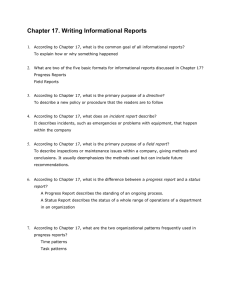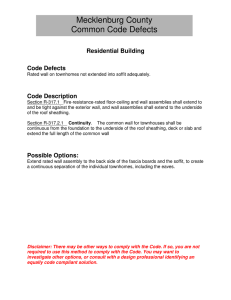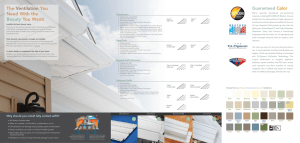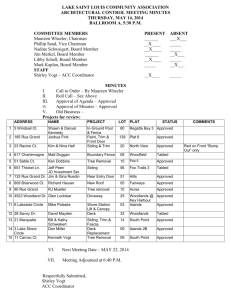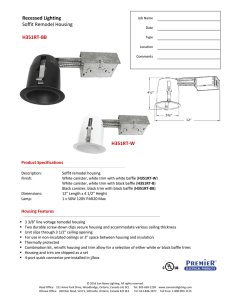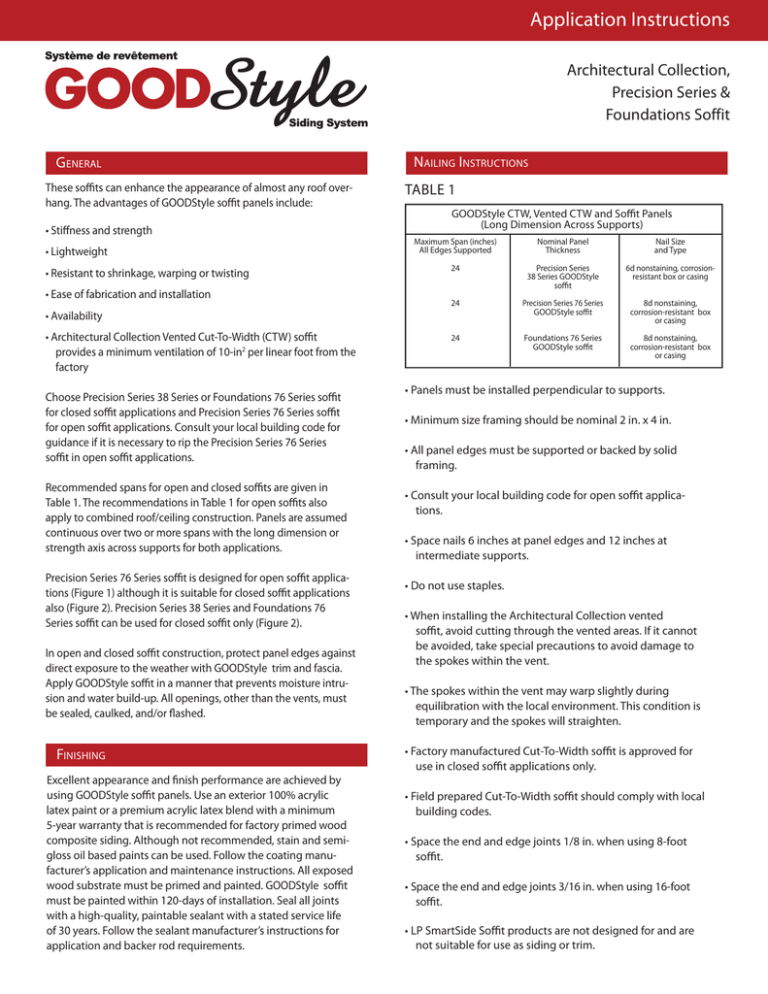
Application Instructions
Architectural Collection,
Precision Series &
Foundations Soffit
GENERAL
These soffits can enhance the appearance of almost any roof overhang. The advantages of GOODStyle soffit panels include:
• Stiffness and strength
• Lightweight
• Resistant to shrinkage, warping or twisting
• Ease of fabrication and installation
NAILING INSTRUCTIONS
TABLE 1
GOODStyle CTW, Vented CTW and Soffit Panels
(Long Dimension Across Supports)
Maximum Span (inches)
All Edges Supported
Nominal Panel
Thickness
Nail Size
and Type
24
Precision Series
38 Series GOODStyle
soffit
6d nonstaining, corrosionresistant box or casing
24
Precision Series 76 Series
GOODStyle soffit
8d nonstaining,
corrosion-resistant box
or casing
24
Foundations 76 Series
GOODStyle soffit
8d nonstaining,
corrosion-resistant box
or casing
• Availability
• Architectural Collection Vented Cut-To-Width (CTW) soffit
provides a minimum ventilation of 10-in2 per linear foot from the
factory
Choose Precision Series 38 Series or Foundations 76 Series soffit
for closed soffit applications and Precision Series 76 Series soffit
for open soffit applications. Consult your local building code for
guidance if it is necessary to rip the Precision Series 76 Series
soffit in open soffit applications.
Recommended spans for open and closed soffits are given in
Table 1. The recommendations in Table 1 for open soffits also
apply to combined roof/ceiling construction. Panels are assumed
continuous over two or more spans with the long dimension or
strength axis across supports for both applications.
Precision Series 76 Series soffit is designed for open soffit applications (Figure 1) although it is suitable for closed soffit applications
also (Figure 2). Precision Series 38 Series and Foundations 76
Series soffit can be used for closed soffit only (Figure 2).
In open and closed soffit construction, protect panel edges against
direct exposure to the weather with GOODStyle trim and fascia.
Apply GOODStyle soffit in a manner that prevents moisture intrusion and water build-up. All openings, other than the vents, must
be sealed, caulked, and/or flashed.
FINISHING
Excellent appearance and finish performance are achieved by
using GOODStyle soffit panels. Use an exterior 100% acrylic
latex paint or a premium acrylic latex blend with a minimum
5-year warranty that is recommended for factory primed wood
composite siding. Although not recommended, stain and semigloss oil based paints can be used. Follow the coating manufacturer’s application and maintenance instructions. All exposed
wood substrate must be primed and painted. GOODStyle soffit
must be painted within 120-days of installation. Seal all joints
with a high-quality, paintable sealant with a stated service life
of 30 years. Follow the sealant manufacturer’s instructions for
application and backer rod requirements.
• Panels must be installed perpendicular to supports.
• Minimum size framing should be nominal 2 in. x 4 in.
• All panel edges must be supported or backed by solid
framing.
• Consult your local building code for open soffit applications.
• Space nails 6 inches at panel edges and 12 inches at
intermediate supports.
• Do not use staples.
• When installing the Architectural Collection vented
soffit, avoid cutting through the vented areas. If it cannot
be avoided, take special precautions to avoid damage to
the spokes within the vent.
• The spokes within the vent may warp slightly during
equilibration with the local environment. This condition is
temporary and the spokes will straighten.
• Factory manufactured Cut-To-Width soffit is approved for
use in closed soffit applications only.
• Field prepared Cut-To-Width soffit should comply with local
building codes.
• Space the end and edge joints 1/8 in. when using 8-foot
soffit.
• Space the end and edge joints 3/16 in. when using 16-foot
soffit.
• LP SmartSide Soffit products are not designed for and are
not suitable for use as siding or trim.
FIGURE 1: Open Soffit
LP APA-rated
sheathing.
Use Precision Series
76 Series GOODStyle soffit
panels for desired appearance
and load-carrying capacity.*
dime
nsion
long
Shim at each rafter for
flush joint, at change
of panel thickness, if
necessary.
Protect edges of
sheathing against
permanent exposure
to weather.
Leave 1/8 in. space
at all panel end and
edge joints for 8-foot
soffit. Support all
edges.
*Do not use 76 Series Foundations Soffit in open soffit applications.
FIGURE 2: Closed Soffit
LP APA-rated
sheathing.
Precision Series
38 Series and
76 Series
Foundations
GOODStyle
soffit panel
The GOODFellow GOODStyle Soffit (the “Products”) limited
warranty (the “Warranty”) applies only to structures on which the
Products have been applied, finished and maintained in accordance
with the published application, finishing and maintenance
instructions in effect at the time of application. The failure to follow
such application, finishing or maintenance instructions will void the
Warranty as to the portion of the Products affected by the variance
(the “Affected Products”).
GOODFellow assumes no liability for any loss or damage sustained
by the Affected Products and is expressly released by the purchaser
or owner from any such loss or liability.
Any modification of the Warranty’s application, finishing or
maintenance requirements is void and unenforceable unless approved
in writing prior to application by the Siding Business Manager or his
designee and a member of the GOODFellow Legal Department.
Protect edges of sheathing against
permanent exposure to weather.
Fascia
Leave 3/16 in. space at
all panel end and edge
joints for 16-foot soffit.
Support all edges.
For a copy of the warranty or for installation and technical support,
visit the GOODStyle product support Web site at:
www.goodfellowinc.com
or for additional support call 800.450.6106.
WARRANTY REMEDIES ARE NOT AVAILABLE IF
REQUIREMENTS ARE NOT FOLLOWED.
Application Instructions
Trim and Fascia Smooth and Cedar
GENERAL
NAILING (CONTINUED)
• There are no National Standards for wood composite substrate trim.
• Leave 1 in. clearance between trim and roofing materials at roof rake.
• GOODStyle trim and fascia can be applied directly over materials such
as siding, or nailed directly to structural members up to 24 in. O.C.
• For edge-nailing, all nail holes must be pre-drilled. Do not attempt to
edge-nail without pre-drilling.
• Do not let trim contact masonry.
• When applied as rake, corner or band board, nails must be spaced
no further than 12 in. apart on alternating edges. Nails must be at
least 3/8 in. from the edge.
• Minimum 6 in. clearance must be maintained between trim and finish
grade.
• Trim applied adjacent to porches, patios, walks, etc. must have a
clearance of at least 3/8 in. above any surface where water might collect.
The surface must be sloped or otherwise designed to provide proper
drainage so the siding is at no time directly exposed to standing water.
• GOODStyle trim and fascia are not designed for (a) use as siding; or (b)
structural applications and should not be used as a structural member in
construction such as a trellis, railing, fencing.
• A non-corrosive drip-edge or drip-cap must be applied at bottom edge of
roofing where it meets the fascia.
• Trim and fascia must not be applied to green or crooked structural
framing members. Do not apply trim and/or fascia over rain soaked or
buckled sheathing materials.
CONDITION
CORRECTION
Snug
OK
Flush
OK
Visible fiber
Paint
Countersunk 1/16–1/8 IN.
Seal with caulking
Countersunk more
than 1/8 in.
Seal with caulk and
re-nail
MOISTURE
• Moisture control and moisture vapor control are critical elements of
proper housing design. Check your local building codes for application
procedures for handling moisture and moisture vapor in your area.
• Follow all applicable building code specifications relating to
prevention of moisture intrusion into the wall assembly. LP SmartSide
trim and fascia is a wood product, and, as with all wood products,
must be kept free from constant sources of moisture. Lack of proper
ventilation; exposure to repetitive sources of water such as sprinklers,
condensation, inadequate flashing; improper sealing; or failure to
follow common building practices that prevent moisture intrusion into
the wall-system; may cause damage, and will void the warranty.
FLASHING, WINDOWS, DOORS & OPENINGS
• All openings must be sealed and flashed in a manner
that prevents moisture intrusion or water buildup. Several
examples that accomplish this are shown.
• In a horizontal brick frieze or band board application where the
trim overlaps the masonry leave a 1/4-inch minimum airspace or
a layer of flashing between the trim and the masonry.
INSIDE CORNER DETAIL
Trim must extend beyond face of siding.
TRIM
increase spacing
according to siding
requirements)
CUTTING
• GOODStyle trim and fascia are manufactured with a special
edge coating which reduces moisture-related issues. Ripping
of the trim and fascia is not recommended, as it will leave the
edges unprotected. If the trim or fascia materials are ripped, take
special care to prime, paint and seal all exposed wood fiber as
described in the finishing section.
1/8 IN.
Gap
Minimum 1/8 IN.
Gap (if necessary,
• GOODFellow will assume no responsibility for water penetration.
• For the cleanest cut and longer blade life, a fine-tooth carbide
tipped blade is recommended.
Sealant
OUTSIDE CORNER DETAIL
Gap 3/16 in.
Minimum 2 in.
behind trim
overlap
Sill
ALTERNATE OUTSIDE CORNER DETAIL
Trim must extend
Minimum
beyond face of siding.
1
/8 IN. Gap
(if necessary,
increase
spacing
according
to siding
requirements)
BUTT JOINT DETAIL
NAILING
GAP 3/16 IN.
• Use a minimum 8d, corrosion resistant (according to
ASTM 641), box style nail, with a minimum 1/4 in. diameter
head.
• Penetrate studs or studs and wood sheathing a combined 1 in.
3
16
• Leave / in. gap where trim butts into other materials and at
butt joints, miter joints and ends. Where edges of trim meet
siding material, windows, doors or other finished openings,
3
leave a minimum /16 in. gap to allow for proper sealing.
Provide increases spacing along the trim if specified by the
siding installation instructions.
Weather
Resistant
Barrier
DOORS & WINDOWS
Minimum 1/8 IN. Gap
(if necessary, increase spacing
according to siding requirements)
Code Approved
Flashing
Trim
HORIZONTAL
TRIM
Siding
1/4 IN.
1/4 IN.
Space
Flashing
Trim
Space
Flashing
Nail Fin (do not damage)
Glass
Brick
Shim
Application instructions (cont.)
STORAGE
GAPS, SEALANT & JOINTS
• Seal all gaps with a high-quality, non-hardening, paintable
sealant with a minimum stated service life of 30 years.
Follow the sealant manufacturer’s instructions for application.
• Store off the ground on a flat surface, under a roof or
separate waterproof covering.
• Keep trim and fascia clean and dry. Inspect prior
to application.
• Allow trim and fascia to adjust to atmospheric conditions
before application.
GABLE ENDS
•
At gable ends, a backer board (such as a barge rafter) should
be used under fascia to provide maximum support along the
length of the product (see Diagram A).
•
If LP SmartSide trim and fascia is installed directly to lookouts on
an overhanging rake, the lookouts must be installed edgewise
and must be spaced no wider than 24 in. O.C. (see Diagram B).
DIAGRAM A
DIAGRAM B
STORE TRIM
FLAT ON STRINGERS
NEVER LIKE THIS
Ridge
First
common rafter
End or verge
rafter
Barge rafter
2x or 4x lookouts
A ladder of lookouts the
same dimension as rafters
and at 16 in. or 24 in. O.C.
provides strength and nailing
for boxed-in rake.
Fascia
Install drip-edge or
drip-cap to prevent
water buildup behind
fascia and trim.
FASCIA DETAIL
FASCIA
SOFFIT
TRIM
FINISHING
DO
The GOODFellow GOODStyle trim and fascia (the “Products”) limited
warranty (the “Warranty”) applies only to structures on which the
Products have been applied, finished and maintained in accordance
with the published application, finishing and maintenance
instructions in effect at the time of application. The failure to follow
such application, finishing or maintenance instructions will void the
Warranty as to the portion of the Products affected by the variance
(the “Affected Products”).
GOODFellow assumes no liability for any loss or damage sustained
by the Affected Products and is expressly released by the purchaser
or owner from any such loss or liability.
Any modification of the Warranty’s application, finishing or
maintenance requirements is void and unenforceable unless approved
in writing prior to application by the Siding Business Manager or his
designee and a member of the GOODFellow Legal Department.
• Prime and paint all exposed surfaces.
• Apply finish coat as soon as possible or within 180 days
of application.
• High-quality acrylic latex paint, specially formulated for
use on wood and engineered wood substrates, is highly
recommended. Semi-gloss or satin finish oil or alkyd paints are
acceptable. For flat alkyd paint, please check with the coating
manufacturer for their recommendations for use on composite
wood siding.
• Follow the coating manufacturer’s application and
maintenance instructions.
DO NOT USE
• Semi-transparent and transparent stains.
• Shake and shingle paints.
• Vinyl-based resin formulas such as vinyl acetate, PVA,
vinyl acetate/acrylic copolymer paints.
For a copy of the warranty or for installation and technical support, visit
the GOODStyle product support Web site at:
www.goodfellowinc.com
or for additional support call 800.450.6106.
WARRANTY REMEDIES ARE NOT AVAILABLE IF
REQUIREMENTS ARE NOT FOLLOWED.
Application Instructions
Architectural Collection,
Precision Series &
Foundations Soffit
GENERAL
These soffits can enhance the appearance of almost any roof overhang. The advantages of GOODStyle soffit panels include:
• Stiffness and strength
• Lightweight
• Resistant to shrinkage, warping or twisting
• Ease of fabrication and installation
NAILING INSTRUCTIONS
TABLE 1
GOODStyle CTW, Vented CTW and Soffit Panels
(Long Dimension Across Supports)
Maximum Span (inches)
All Edges Supported
Nominal Panel
Thickness
Nail Size
and Type
24
Precision Series
38 Series GOODStyle
soffit
6d nonstaining, corrosionresistant box or casing
24
Precision Series 76 Series
GOODStyle soffit
8d nonstaining,
corrosion-resistant box
or casing
24
Foundations 76 Series
GOODStyle soffit
8d nonstaining,
corrosion-resistant box
or casing
• Availability
• Architectural Collection Vented Cut-To-Width (CTW) soffit
provides a minimum ventilation of 10-in2 per linear foot from the
factory
Choose Precision Series 38 Series or Foundations 76 Series soffit
for closed soffit applications and Precision Series 76 Series soffit
for open soffit applications. Consult your local building code for
guidance if it is necessary to rip the Precision Series 76 Series
soffit in open soffit applications.
Recommended spans for open and closed soffits are given in
Table 1. The recommendations in Table 1 for open soffits also
apply to combined roof/ceiling construction. Panels are assumed
continuous over two or more spans with the long dimension or
strength axis across supports for both applications.
Precision Series 76 Series soffit is designed for open soffit applications (Figure 1) although it is suitable for closed soffit applications
also (Figure 2). Precision Series 38 Series and Foundations 76
Series soffit can be used for closed soffit only (Figure 2).
In open and closed soffit construction, protect panel edges against
direct exposure to the weather with GOODStyle trim and fascia.
Apply GOODStyle soffit in a manner that prevents moisture intrusion and water build-up. All openings, other than the vents, must
be sealed, caulked, and/or flashed.
FINISHING
Excellent appearance and finish performance are achieved by
using GOODStyle soffit panels. Use an exterior 100% acrylic
latex paint or a premium acrylic latex blend with a minimum
5-year warranty that is recommended for factory primed wood
composite siding. Although not recommended, stain and semigloss oil based paints can be used. Follow the coating manufacturer’s application and maintenance instructions. All exposed
wood substrate must be primed and painted. GOODStyle soffit
must be painted within 120-days of installation. Seal all joints
with a high-quality, paintable sealant with a stated service life
of 30 years. Follow the sealant manufacturer’s instructions for
application and backer rod requirements.
• Panels must be installed perpendicular to supports.
• Minimum size framing should be nominal 2 in. x 4 in.
• All panel edges must be supported or backed by solid
framing.
• Consult your local building code for open soffit applications.
• Space nails 6 inches at panel edges and 12 inches at
intermediate supports.
• Do not use staples.
• When installing the Architectural Collection vented
soffit, avoid cutting through the vented areas. If it cannot
be avoided, take special precautions to avoid damage to
the spokes within the vent.
• The spokes within the vent may warp slightly during
equilibration with the local environment. This condition is
temporary and the spokes will straighten.
• Factory manufactured Cut-To-Width soffit is approved for
use in closed soffit applications only.
• Field prepared Cut-To-Width soffit should comply with local
building codes.
• Space the end and edge joints 1/8 in. when using 8-foot
soffit.
• Space the end and edge joints 3/16 in. when using 16-foot
soffit.
• LP SmartSide Soffit products are not designed for and are
not suitable for use as siding or trim.
FIGURE 1: Open Soffit
LP APA-rated
sheathing.
Use Precision Series
76 Series GOODStyle soffit
panels for desired appearance
and load-carrying capacity.*
dime
nsion
long
Shim at each rafter for
flush joint, at change
of panel thickness, if
necessary.
Protect edges of
sheathing against
permanent exposure
to weather.
Leave 1/8 in. space
at all panel end and
edge joints for 8-foot
soffit. Support all
edges.
*Do not use 76 Series Foundations Soffit in open soffit applications.
FIGURE 2: Closed Soffit
LP APA-rated
sheathing.
Precision Series
38 Series and
76 Series
Foundations
GOODStyle
soffit panel
The GOODFellow GOODStyle Soffit (the “Products”) limited
warranty (the “Warranty”) applies only to structures on which the
Products have been applied, finished and maintained in accordance
with the published application, finishing and maintenance
instructions in effect at the time of application. The failure to follow
such application, finishing or maintenance instructions will void the
Warranty as to the portion of the Products affected by the variance
(the “Affected Products”).
GOODFellow assumes no liability for any loss or damage sustained
by the Affected Products and is expressly released by the purchaser
or owner from any such loss or liability.
Any modification of the Warranty’s application, finishing or
maintenance requirements is void and unenforceable unless approved
in writing prior to application by the Siding Business Manager or his
designee and a member of the GOODFellow Legal Department.
Protect edges of sheathing against
permanent exposure to weather.
Fascia
Leave 3/16 in. space at
all panel end and edge
joints for 16-foot soffit.
Support all edges.
For a copy of the warranty or for installation and technical support,
visit the GOODStyle product support Web site at:
www.goodfellowinc.com
or for additional support call 800.450.6106.
WARRANTY REMEDIES ARE NOT AVAILABLE IF
REQUIREMENTS ARE NOT FOLLOWED.
Application instructions
General
•At the time of manufacture, siding meets or exceeds the performance standards set forth in Composite Panel Association ANSI
135.6-2006 and has achieved code recognition under Legacy National Evaluation Report NER-626 and CCMC-12353L. For copies
of these reports, call LP Customer Support at 1-800-577-4836.
• Minimum 6 in. clearance must be maintained between siding
and finish grade.
•Siding applied adjacent to porches, patios, walks, etc. must
have a clearance of at least 1 in. above any surface.
architectural collection
cedar shake 76 series lap siding
• Siding must not be applied to green or crooked structural framing members. Do not apply siding over rain-soaked or buckled
sheathing materials.
• Gutters are recommended for control of roof water run off.
Vapor Retarder/Weather Barrier
• A properly installed breathable water-resistive barrier is
required behind the siding.
• Consult your local building code for details.
• LP will assume no responsibility for water penetration.
•Minimum 1" clearance at intersection with roof line
•Apply siding in a manner that prevents moisture intrusion and
water buildup.
•All exposed wood substrate must be primed and painted in a
manner that prevents moisture intrusion and water buildup.
•In non-traditional ICF and SIP assemblies, the ICF or SIP manufacturer must prescribe the fastening specifications. Note: LP
does not recommend LP SmartSide for use in these non-traditional assemblies. If used, LP will not warrant for Buckling and
Shrinkage. However, balance of warranty does remain intact.
•When using wet blown cellulose insulation, adequate drying
time must be allowed prior to enclosing the wall cavity
• DO NOT USE STAPLES
Storage
Gaps & Sealants
• Seal all gaps with a high-quality, non-hardening, paintable
sealant with a minimum stated service life of 30 years. Follow
the sealant manufacturer’s instructions for application.
Flashing, Windows, Doors & Openings
•A
ll openings must be properly sealed or flashed in a manner that
prevents moisture intrusion or buildup. Several examples that
accomplish this are shown on the following pages.
Trim
Trim should be thick enough so the siding does not extend beyond the face of the trim.
•Store off the ground well supported, on a flat surface, under a
roof or separate waterproof covering
• Trim and fascia must be applied in a manner that will not allow
moisture intrusion or water buildup.
•Keep siding clean and dry. Inspect prior to application.
• LP® SmartSide® siding is not designed and/or manufactured
to be used as trim or fascia. LP SmartSide trim and fascia are
available in a variety of dimensions.
• Allow siding to adjust to atmospheric conditions before application.
Stud Spacing
• Cedar Shake Lap Siding may be applied over sheathed walls
or where building codes permit, directly to studs spaced no
greater than 16" O.C. that have adequate corner bracing.
• In all installations over masonry walls, the wall must be furredout with top and bottom openings for convective ventilation.
The maximum framing span is 16" O.C. and the furring must be
a minimum of 1-1/2" thick.
Moisture
• Moisture control and moisture vapor control are critical elements of
proper housing design. Check your local building codes for application
procedures for handling moisture and moisture vapor in your area.
• As with all wood products, do not apply engineered wood siding to a
structure having excessive moisture conditions such as drying concrete or plaster. If such conditions exist, the building should be well
ventilated to allow it to dry prior to the application of the siding.
Finishing Instructions
DO
• Priming all exposed wood substrates before painting is highly
recommended.
• Paint all exposed siding surfaces including drip edges.
• T
horoughly paint the bottom edges of siding especially
all cut ends next to the roof line.
• A
pply paint as soon as possible and within 180 days of application.
• F
ollow the coating manufacturer's application and maintenance instructions.
• H
igh-quality acrylic latex paint, specially formulated for use
on wood and engineered wood substrates, is highly recommended. Semi-gloss or satin finish oil or alkyd paints are
acceptable. For flat alkyd paint, please check with the coating
manufacturers for their recommendations for use on composite wood siding.
Application instructions (cont.)
Siding Applicator Instructions
a)Apply siding over properly prepared walls (see General Information) with a maximum stud spacing of 16 in. o.c.
b) Begin by nailing a starter strip (approximately 3/8 in. x
1-1/2 in.), flush with bottom edge of sill plate.
Starting from left to right, level and install the first course
of Cedar Shake Lap Siding so bottom edge is no more than
1/2 in. below the shim. Trim left edge so that siding section
fits against corner board, with a 3/16 in. gap, and so that opposite shiplap edge falls on a stud for nailing.
Use “alignment notch” in shiplap edge as automatic guide to
lap each siding course. Lap a minimum of 1-3/4 in. to bottom
of notch, as shown. Nail 3/4 in. from bottom edge to penetrate both siding courses.
c) Start subsequent courses in same manner but trim each course
to effect staggered joints. Best appearance is obtained by
trimming second course starter piece 16 in. shorter than the
first course and trimming the third course starter piece 32 in.
shorter than the first. Repeat this same sequence every three
courses.
The Louisiana-Pacific Corporation (“LP”) LP SmartSide Siding (the
“Products”) limited warranty (the “Warranty”) applies only to
structures on which the Products have been applied, finished and
maintained in accordance with the published application, finishing
and maintenance instructions in effect at the time of application.
The failure to follow such application, ­finishing or maintenance
instructions will void the Warranty as to the portion of the Products
affected by the variance (the “Affected Products”).
LP assumes no liability for any loss or damage sustained by the
Affected Products and is expressly released by the purchaser or
owner from any such loss or liability.
Any modification of the Warranty’s application, finishing or
maintenance requirements is void and unenforceable unless
approved in writing prior to application by the Siding General
Manager or his designee and a member of the LP Legal Department.
For a copy of the warranty or for installation and technical support, visit
the LP SmartSide product s­ upport Web site at:
www.lpcorp.com
or for additional support call 800.450.6106.
Warranty remedies are not available if
requirements are not followed.
DO NOT OVERDRIVE NAILS. Nail head should seat firmly
to face of siding, but not be overdriven to distort the siding
surface.
All siding joints must fall on studs. At shiplap edges, double
nailing is required.
Nailing
d) NAILS MUST PENETRATE FRAMING MEMBERS AT LEAST
1-1/2 in.
For best performance use hot-dipped galvanized nails with
a minimum 1/4 in. diameter head. Nail at all special framing
members around openings (maximum spacing 16 in. o.c.).
Shim, if necessary, to provide solid backing for siding fitted
around windows, doors, and at rake cuts on gable ends.
e) When installing siding over maximum 1 in. foam sheathing,
care must be taken not to drive nails so hard as to compress
the foam and distort the siding surface.
f)LP SmartSide siding should be sawn face up with a fine-tooth
handsaw, or face down with a combination blade power saw.
g)Where siding butts window trim, door casing, masonry, etc.,
leave a 3/16 in. gap and seal.
© 2010 Louisiana-Pacific Corporation. All rights reserved. LP and SmartSide are registered trademarks
of Louisiana-Pacific Corporation. Printed in U.S.A.
NOTE: Louisiana-Pacific Corporation periodically updates and revises its product i­ nformation.
To verify that this version is current, call 800-450-6106.
LPZB0507
roof flashing detail
joint treatment
1 in.
Trim
3/8
in.
over openings
flash, shim,
gap 3/16 in.
ensure complete
paint coverage of
the drip edge
Min. 3/16 in. gap
4 in. min. flashing
Paint bottom
edges
1 in. min. clearance
from roofing
Breathable
weather
resistant
barrier
gap 3/16 in.
and seal
gap 3/16 in.
and seal
starter strip
outside corner
detail
inside corner
detail
bottom course
detail
1-1/2 in. minimum
1-3/4 in.
Breathable
weather
resistant
barrier
exposure
10 in.
3/4 in.
nailing detail
1 in.
1-1/4 in.
alignment notch detail
3/4 in.
1-1/4 in.
ends of shakes must fall on studs
Application instructions
precision series 38 series, 76 series, 190 series
primed panel siding Including Silvertech & SmartFinish
(smooth square edge panel siding is approved
for use with Carrara Stucco Finish ONLY)
General
• At the time of manufacture, LP's Precision Series primed panel
siding meets or exceeds the performance standards set forth in
ICC-ES acceptance criteria ACC321 and has achieved code recognition under the ICC-ES Report ESR-1301, and HUD recognition
under HUD-MR-1318. For copies of ESR-1301, call LP Customer
Support at 1-800-648-6893 or go on-line at http://www.icc-es.
org/reports/pdf_files/ICC-ES/ESR-1301.pdf.
• Minimum 6 in. clearance must be maintained between siding
and finish grade.
Moisture
• Moisture control and moisture vapor control are critical elements of
proper housing design. Check your local building codes for application
procedures for handling moisture and moisture vapor in your area.
• As with all wood products, do not apply engineered wood siding
to a structure having excessive moisture conditions such as drying
concrete or plaster. If such conditions exist, the building should
be well ventilated to allow it to dry prior to the application of the
siding.
• S
iding applied adjacent to porches, patios, walks, etc. must have
a clearance of at least 1 in. mm above any surface.
• Siding must not be applied to green or crooked structural framing members. Do not apply siding over rain-soaked or buckled
sheathing materials.
• Minimum 1 in. clearance at intersection with roof line
• Gutters are recommended for control of roof water run off.
• A
pply siding in a manner that prevents moisture intrusion and
water buildup.
Secondary Weather Resistant Barrier
• All
exposed wood substrate must be sealed in a manner that
prevents moisture intrusion and water buildup.
• A properly installed breathable water-resistive barrier is required behind the siding.
• I n non-traditional ICF and SIP assemblies, the ICF or SIP manufacturer must prescribe the fastening specifications. Note: LP
does not recommend LP SmartSide Panel for use in these nontraditional assemblies. If used, LP will not warrant for Buckling
and Shrinkage. However, balance of warranty does remain intact. • Consult your local building code for details.
• When using wet blown cellulose insulation, the insulation must
not be in direct contact with the siding and it must be allowed
to dry a minimum of 24 hours or longer if specified by the insulation manufacturer.
• LP will assume no responsibility for water penetration.
Gaps & Sealants
• Seal all gaps with a high-quality, non-hardening, paintable sealant with a minimum stated service life of 30 years. Follow
the sealant manufacturer’s instructions for application.
• DO NOT USE STAPLES
Flashing, Windows, Doors & Openings
Storage
• S
tore off the ground well supported, on a flat surface, under a
roof or separate waterproof covering
• Keep siding clean and dry. Inspect prior to application.
• Allow siding to adjust to atmospheric conditions before application.
Stud Spacing
• Precision Series 38 Series and 76 Series panel siding must be installed on 16 in. OC framing only. When installing on 24 in. OC
framing, Precision Series 190 Series panel siding is required.
• All openings must be properly sealed or flashed in a manner that
prevents moisture intrusion or buildup. Several examples that
accomplish this are shown on the following pages.
Trim
Trim should be thick enough so the siding does not extend beyond the face of the trim.
• Trim and fascia must be applied in a manner that will not allow
moisture intrusion or water buildup.
• LP® SmartSide® siding is not designed and/or manufactured
to be used as trim or fascia. LP SmartSide trim and fascia are
available in a variety of dimensions.
Application instructions (cont.)
Nailing Instructions
Kick-Out Flashing
• Install kick-out flashing to direct the water into the gutter
• Install step flashing with minimum 4-inch upper leg
• Properly integrate flashing with the secondary water-resistive
barrier. Use housewrap, flashing tape, z-flashing, or other items as needed to maintain the counterflashing principle.
• DO NOT extend the siding or trim into the kick-out flashing or gutter
• Maintain a clearance between the end of the gutter and the adjoining
wall to allow for proper maintenance of the siding
• In braced wall assemblies, use minimum 6d (0.113 in. shank
diameter), corrosion resistant according to ASTM 641, nails for
38 Series and 76 Series panels and minimum 8d (0.131 in. shank
diameter) for 190 Series panels. Do not use electroplated fasteners. Refer to your local building code to verify the minimum
allowable fastener size.
• Penetrate studs or studs and wood sheathing a combined minimum of 1-1/2 in.
3/8 in. min. from edge
Alignment bead
• Paint ALL exposed cut edges
1/8 in. gap
LP Siding
Minimum 1" clearance
between trim and roofing
Nail
penetration
min. 1-1/2 in.
Figure 1
Single row of nails
Alignment bead
1/8 in. gap
Clean rain
gutter
Do not run trim or siding inside
of the kick out flashing
Finishing Instructions
DO
• Prime and paint all exposed surfaces including all drip
edges or where water will hang.
• Apply finish coat as soon as possible or within 180 days of application.
• High-quality acrylic latex paint, specially formulated for
use on wood and engineered wood substrates, is highly
recommended. Semi-gloss or satin finish oil or alkyd paints are
acceptable. For flat alkyd paint, please check with the coating
manufacturer for their recommendations for use on composite
wood siding.
• Follow the coating manufacturer’s application and maintenance instructions.
DO NOT USE
• Semi-transparent and transparent stains.
• Shake and shingle paints.
• Vinyl-based resin formulas such as vinyl acetate, PVA, vinyl acetate/acrylic copolymer paints.
Figure 2
Double row of nails
• For 38 Series panels, double nailing procedure meets wall bracing requirements and 5/16 in. shear wall design values.
• For 76 Series and 190 Series panels, single nailing meets wall
bracing requirements. To meet the equivalent 3/8 in. shear wall
design values, double nailing procedures must be used. It may
be necessary to angle drive the second nail in order to penetrate
the framing. Seal nails driven below the surface.
• Shear values for panels applied directly to studs shall be no
greater than noted in Table 1 of the ICC-ES report ESR-1301.
• Not warranted for application on SIP and ICF assemblies.
CAUTION
• 38 Series and 76 Series panels must be installed on 16 in. OC
framing only. When installing on 24 in. OC framing, 190 Series
panels are required.
• Backside of panel must not come in contact with masonry
foundation.
• Do not force siding into place. Maintain the illustrated 1/8 in.
space behind the joint to allow for expansion while the panel
equilibrates with the local environment.
• LP® SmartSide® Panel siding must not be attached by stapling.
• DO NOT INSTALL OVER ALIGNMENT BEAD. Install panels in
light contact to the edge of alignment bead. (see above drawing)
Application instructions (cont.)
Insulated Sheathings
LP SmartSide Sidings may be installed over low-compression rigid
foam or fiberglass sheathings. The following precautions must be
followed:
1 in. Roof & Chimney Clearance
a) Adequate bracing of the wall in accordance with the International
Codes or other ruling building code is required.
b) For rigid foam sheathing up to 1" (25.4 mm) thick, siding may be
nailed directly to the foam sheathing unless a drainage plane
is required by the local building code. Nail length must be increased to ensure a minimum 1-1/2” (38.1 mm) fastener penetration into the structural framing.
c) For rigid foam sheathing greater than 1" (25.4 mm), a minimum
1-1/2” (38.1 mm) thick by 4” (101.6 mm) wide vertical strapping
or furring strip must be installed over the sheathing to provide
a solid, level nailing base for the siding. The strapping must be
securely fastened to structural framing spaced no greater than
16” OC (406 mm) with a minimum nail penetration of 1-1/2 inches
(38.1 mm) and a maximum nail spacing no greater than the width
of the siding.
Louisiana-Pacific will assume no responsibility for any damage or
condition arising from the use of foam sheathing.
Trim
Min. 3/16
in. space at
joint
4 in. min. flashing
Paint bottom
edges
1 in. min.
clearance from
roofing
Figure 4
LP SmartSide Panel Siding Joint Details
HORIZONTAL Wall joints
Nail a min 3/8 in.
from edge
12 in. max.
field nail
spacing
6 in. max.
perimeter nail
spacing
Nail corner first
6 in. max. perimeter nail spacing
Do not let panel
contact masonry
Figure 3
6 in. min. ground
clearance
Masonry
LAP
Siding
BUTT & FLASH
3/8 in.
min. gap
Siding
Blocking
Blocking
1 in. min.
overlap
Sloped flashing
(galv. or aluminum)
Lap top panel
over bottom
panel
Figure 5B
Figure 5A
LAPPED HORIZONTAL WALL JOINT
Siding
Framing (band joist,
truss chord, etc.)
CONDITION
CORRECTION
Snug
OK
Flush
OK
Visible fiber
Paint
Countersunk 1/16 in.-1/8 in.
Seal with caulking
Countersunk more
than 1/8 in.
Seal with caulk
and renail
1 in. min.
overlap
Wall Framing
Figure 5C
HORIZONTAL beltline joints
For multi-story buildings, make provisions at horizontal joints for
“setting” shrinkage of framing, especially when applying siding
directly to studs.
Siding (4 ft. x 8 ft.)
3/8 in. gap
Aluminum or galv.
flashing
BAND BOARD OVER
PANEL FILLER
2 in. x 10 in.
band board
Filler Board
Siding (4 ft. x 8 ft.)
Figure 6
Siding Must Not Contact Masonry
Stud
Bottom plate
OR
Sill plate
Floor system
Extend
siding
below
sill plate
Flashing or
moisture
barrier
Min. 1/8 in. or
flashing between
siding and
masonry.
LP assumes no liability for any loss or damage sustained by the
Affected Products and is expressly released by the purchaser or owner
from any such loss or liability.
Any modification of the Warranty’s application, finishing or
maintenance requirements is void and unenforceable unless approved
in writing prior to application by the Siding General Manager or his
designee and a member of the LP Legal Department.
Masonry
foundation
Figure 7A
Figure 7B
or for additional support call 800.450.6106.
Header
Siding
Code Approved Breathable
Water-Resistive Barrier
Casing
For a copy of the warranty or for installation and technical support, visit the
LP SmartSide product ­support Web site at:
www.lpcorp.com
Gap, Flash Doors & Windows
Interior Wall
Finish
The Louisiana-Pacific Corporation (“LP”) LP SmartSide Siding (the
“Products”) limited warranty (the “Warranty”) applies only to
structures on which the Products have been applied, finished and
maintained in accordance with the published application, finishing
and maintenance instructions in effect at the time of application. The
failure to follow such application, ­finishing or maintenance instructions
will void the Warranty as to the portion of the Products affected by the
variance (the “Affected Products”).
Warranty remedies are not available if
requirements are not followed.
3/8 in. gap
Code Approved
Flashing
Insulation
Filler
Space according
to the window/door
manufacturer’s instruction
Trim
Nail fin
(do not damage)
Figure 8
4 ft. x 8 ft. Ungrooved Shiplap Panel
Scant face width
Figure 9
1/8 in. gap
Space joint 1/8 in.
Refer to nailing instructions
1/8 in. gap
Cal. Prop 65 Warning: Use of this product may result in
exposure to wood dust, known to the State of California
to cause cancer.
© 2012 Louisiana-Pacific Corporation. All rights reserved. LP, SmartSide, SilverTech and SmartFinish
are registered trademarks of Louisiana-Pacific Corporation. Printed in U.S.A.
NOTE: Louisiana-Pacific Corporation periodically updates and revises its product i­ nformation.
To verify that this version is current, call 800-450-6106.
LPZB0512
gap 3/16 in. and seal
gap 3/16 in.
and seal
Figure 10B
Figure 10A
Figure 10
Vapor Retarder
.
6 in
n.
12 i
6 in.
6 in. minimum
Figure 10C
Figure 10E
Figure 10D

